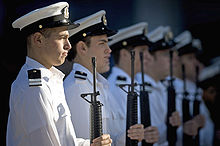

This article has multiple issues. Please help improve it or discuss these issues on the talk page. (Learn how and when to remove these template messages)
|

The Israeli Naval Academy is a voluntary course, dedicated to the training, education and selection of Naval Officers, and it takes place alongside other instructional courses at the Naval Command School in the Israeli Naval Training Base. The Naval Academy is considered one of the most prestigious and demanding courses in the IDF – alongside the Israeli Air Force Flight Academy. On average, only one out of four cadets completes the course successfully, representing a 10% completion rate from initial selection process to graduation. The course is nearly three years long, and cadets graduate with a B.A. from Haifa University and an Officer rankofLieutenant. Graduates are committed to 61 months' additional military service.
The selection process for navy cadets is a long and complex process. Potential Israeli Cadets are identified prior to reporting for national service at age 18, based on factors such as high grades in school and top scores on standardized tests, excellent physical condition and high technical aptitude.
All recruits with the appropriate personal indicators then report to the "elite unit day"; a 1-2 day battery of tests which mainly gauge physical effort. Only a select few will proceed from this step to the mental aptitude testing battery, which takes place at the Navy Pavilion in Tel-Hashomer. (Women, and men unable to participate in elite unit day because of special circumstances, usually medical, start the selection process directly at this stage). The mental aptitude testing battery consists mainly of mental and psychological tests, and only around 30% of those tested will qualify for the next stage, while those who did not pass are sometimes given an opportunity to try out for other special units within the Navy, such as the submarines flotilla.
Those who successfully complete all of the above testing phases are invited to participate in a four-day gibush (cohesion), a selection phase involving physical, mental, and sociometric challenges. Recruits are screened not only for their ability to perform the tasks assigned, but for their attitude in performing them – such as how they take hardships and unexpected difficulties, how well they work in groups and how they approach problem solving and disaster management situations. As many as 80% percent of those who commence the gibush will be dropped from further consideration at its conclusion.
Those who pass the gibush embark on an almost three-year journey to graduation, which includes extensive naval training, infantry training, an officer's course, and studies towards an academic degree (aB.A.) The cadets are evaluated constantly, and the vast majority of those who begin their studies in the Naval Academy do not make it through the full program. Those expelled from the course will either remain in the Navy as officers in support positions, or transfer to an army unit. This depends to a large degree on the stage at which they leave the course. Most of those expelled qualify for transfer to the Israeli Special Forces.
The cadets are divided into areas of expertise, each with corresponding posts after graduation:
Cadets first go through basic infantry training for four weeks at Navy Training School, where they are provided basic principles of military service, as well as a high level of discipline.
This stage lasts about six months and includes the "seamanship and command" phase. during this phase the cadet is first faced with challenges and difficulties in the sea, along with a very high level of physical training, and strict discipline. At the end of this stage, cadets undergo a 72-hour cruise in an Inflatable boat. At the end of the "seamanship and command" phase the cadets return to the Israeli Naval Instruction Base in Haifa, where cadets receive continuing vocational regarding the operation and command of larger vessels.
During this phase, the identifying rank markings are dark blue Epaulettes. After completion of the "seamanship and command" phase, a white stripe is added to the Epaulettes. At this point, and during the rest of the course the students wear a beret with a white stripe around the edge, and a white background behind the symbol of the Navy.
This stage lasts about six months and differs between the various areas of expertise.
During this stage the cadets undergo a two-star level diving course.
During this phase, the Epaulettes are dark blue with two white stripes.
This stage lasts about nine months and consists of academic studies at Haifa University for a B.A in political science, combined with lessons about naval and military strategy. In the past, the cadets used to go through an undergraduate multidisciplinary curriculum which included: political science, economics, business administration, as well as maritime subjects and naval history, but beginning from class 130(2013), it was upgraded to a unique political science degree.
During this phase, the Epaulettes are dark blue with a golden anchor pin.

This stage lasts about eight months and includes practical and theoretical training in the designated position aboard the ship. During this phase, the Epaulettes are dark blue with a golden anchor pin above a white stripe.
This stage lasts about four months during which the cadets undergo internship and operate aboard their designated vessels as vice-officers in their areas of study. During this phase, the Epaulettes are dark blue with a golden anchor pin above two white stripes.
The end of this phase marks the end of the course, after which the graduation ceremony takes place at the Naval Training School, where graduates receive the naval officer pin and lieutenant rank.